16.6E: Exercícios para a Seção 16.6
- Page ID
- 188482
Nos exercícios 1 a 4, determine se as afirmações são verdadeiras ou falsas.
1. Se a superfície\(S\) for dada por\(\{(x,y,z) : \, 0 \leq x \leq 1, \, 0 \leq y \leq 1, \, z = 10 \}\), então\(\displaystyle \iint_S f(x,y,z) \, dS = \int_0^1 \int_0^1 f (x,y,10) \, dx \, dy.\)
- Resposta
- É verdade
2. Se a superfície\(S\) for dada por\(\{(x,y,z) : \, 0 \leq x \leq 1, \, 0 \leq y \leq 1, \, z = x \}\), então\(\displaystyle \iint_S f(x,y,z) \, dS = \int_0^1 \int_0^1 f (x,y,x) \, dx \, dy.\)
3. A superfície\(\vecs r = \langle v \, \cos u, \, v \, \sin u, \, v^2 \rangle,\) para\( 0 \leq u \leq \pi, \, 0 \leq v \leq 2\) é a mesma superfície\(\vecs r = \langle \sqrt{v} \, \cos 2u, \, \sqrt{v} \, \sin 2u, \, v \rangle,\) para\( 0 \leq u \leq \dfrac{\pi}{2}, \, 0 \leq v \leq 4\).
- Resposta
- É verdade
4. Dada a parametrização padrão de uma esfera, os vetores normais\(t_u \times t_v\) são vetores normais externos.
Nos exercícios 5 a 10, encontre descrições paramétricas para as seguintes superfícies.
5. Avião\(3x - 2y + z = 2\)
- Resposta
- \(\vecs r(u,v) = \langle u, \, v, \, 2 - 3u + 2v \rangle \)para\(-\infty \leq u < \infty\)\( - \infty \leq v < \infty\) e.
6. Parabolóide\(z = x^2 + y^2\), para\(0 \leq z \leq 9\).
7. Avião\(2x - 4y + 3z = 16\)
- Resposta
- \(\vecs r(u,v) = \langle u, \, v, \, \dfrac{1}{3} (16 - 2u + 4v) \rangle \)para\(|u| < \infty\)\(|v| < \infty\) e.
8. O tronco do cone\(z^2 = x^2 + y^2\), para\(2 \leq z \leq 8\)
9. A porção do cilindro\(x^2 + y^2 = 9\) no primeiro octante, para\(0 \leq z \leq 3\)
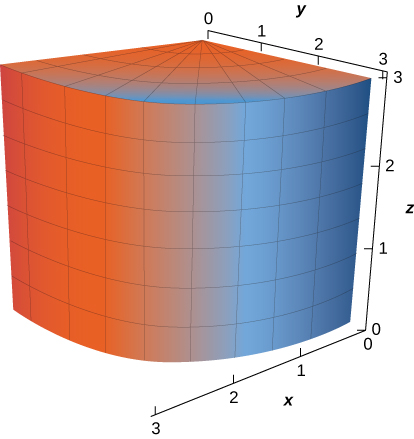
- Resposta
- \(\vecs r(u,v) = \langle 3 \, \cos u, \, 3 \, \sin u, \, v \rangle \) for \(0 \leq u \leq \dfrac{\pi}{2}, \, 0 \leq v \leq 3\)
10. A cone with base radius \(r\) and height \(h,\) where \(r\) and \(h\) are positive constants.
For exercises 11 - 12, use a computer algebra system to approximate the area of the following surfaces using a parametric description of the surface.
11. [T] Half cylinder \(\{ (r, \theta, z) : \, r = 4, \, 0 \leq \theta \leq \pi, \, 0 \leq z \leq 7 \}\)
- Answer
- \(A = 87.9646\)
12. [T] Plane \(z = 10 - z - y\) above square \(|x| \leq 2, \, |y| \leq 2\)
In exercises 13 - 15, let \(S\) be the hemisphere \(x^2 + y^2 + z^2 = 4\), with \(z \geq 0\), and evaluate each surface integral, in the counterclockwise direction.
13. \(\displaystyle \iint_S z\, dS\)
- Answer
- \(\displaystyle \iint_S z \, dS = 8\pi\)
14. \(\displaystyle \iint_S (x - 2y) \, dS\)
15. \(\displaystyle \iint_S (x^2 + y^2) \, dS\)
- Answer
- \(\displaystyle \iint_S (x^2 + y^2) \, dS = 16 \pi\)
In exercises 16 - 18, evaluate \(\displaystyle \int \int_S \vecs F \cdot \vecs N \, dS\) for vector field \(\vecs F\) where \(\vecs N\) is an outward normal vector to surface \(S.\)
16. \(\vecs F(x,y,z) = x\,\mathbf{\hat i}+ 2y\,\mathbf{\hat j} = 3z\,\mathbf{\hat k}\), and \(S\) is that part of plane \(15x - 12y + 3z = 6\) that lies above unit square \(0 \leq x \leq 1, \, 0 \leq y \leq 1\).
17. \(\vecs F(x,y) = x\,\mathbf{\hat i} + y\,\mathbf{\hat j}\), and \(S\) is hemisphere \(z = \sqrt{1 - x^2 - y^2}\).
- Answer
- \(\displaystyle \iint_S \vecs F \cdot \vecs N \, dS = \dfrac{4\pi}{3}\)
18. \(\vecs F(x,y,z) = x^2\,\mathbf{\hat i} + y^2\,\mathbf{\hat j} + z^2\,\mathbf{\hat k}\), and \(S\) is the portion of plane \(z = y + 1\) that lies inside cylinder \(x^2 + y^2 = 1\).
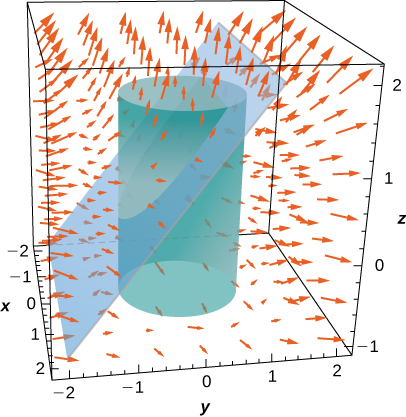
Nos exercícios 19 a 20, aproxime a massa da lâmina homogênea que tem a forma de determinada superfície.\(S.\) Arredonde até quatro casas decimais.
19. [T]\(S\) é superfície\(z = 4 - x - 2y\), com\(z \geq 0, \, x \geq 0, \, y \geq 0; \, \xi = x.\)
- Resposta
- \(m \approx 13.0639\)
20. [T]\(S\) é superfície\(z = x^2 + y^2\), com\(z \leq 1; \, \xi = z\).
21. [T]\(S\) é superfície\(x^2 + y^2 + x^2 = 5\), com\(z \geq 1; \, \xi = \theta^2\).
- Resposta
- \(m \approx 228.5313\)
22. Avalie\(\displaystyle \iint_S (y^2 z\,\mathbf{\hat i}+ y^3\,\mathbf{\hat j} + xz\,\mathbf{\hat k}) \cdot dS,\) onde\(S\) está a superfície do cubo\(-1 \leq x \leq 1, \, -1 \leq y \leq 1\) e\(0 \leq z \leq 2\) no sentido anti-horário.
23. Avalie a integral da superfície\(\displaystyle \iint_S g \, dS,\) onde\(g(x,y,z) = xz + 2x^2 - 3xy\) e\(S\) é a parte do plano\(2x - 3y + z = 6\) que fica sobre a unidade quadrada\(R: 0 \leq x \leq 1, \, 0 \leq y \leq 1\).
- Resposta
- \(\displaystyle \iint_S g\,dS = 3 \sqrt{4}\)
24. Avalie\(\displaystyle \iint_S (x + y + z)\, dS,\) onde\(S\) está a superfície definida parametricamente\(\vecs R(u,v) = (2u + v)\,\mathbf{\hat i} + (u - 2v)\,\mathbf{\hat j} + (u + 3v)\,\mathbf{\hat k}\) por for\(0 \leq u \leq 1\),\(0 \leq v \leq 2\) e.
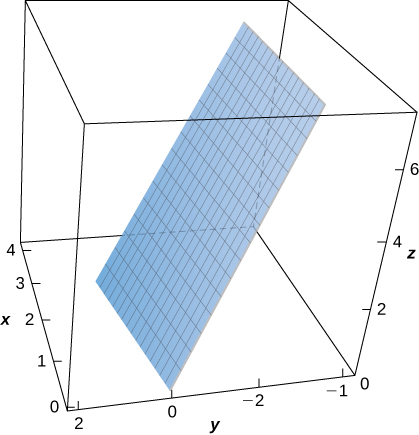
25. [T] Avaliar\(\displaystyle \iint_S (x - y^2 + z)\, dS,\) where \(S\) is the surface defined parametrically by \(\vecs R(u,v) = u^2\,\mathbf{\hat i} + v\,\mathbf{\hat j} + u\,\mathbf{\hat k}\) for \(0 \leq u \leq 1, \, 0 \leq v \leq 1\).
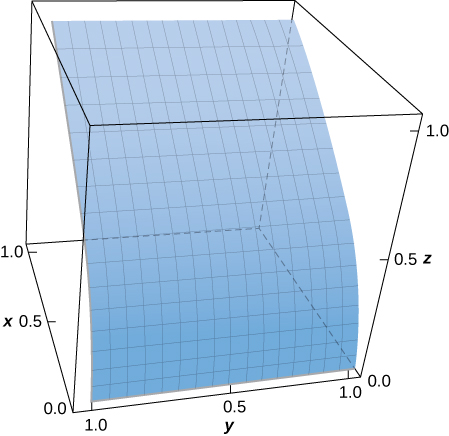
- Resposta
- \(\displaystyle \iint_S (x^2 + y - z) \, dS \approx 0.9617\)
26. [T] Avalie onde\(S\) está a superfície definida\(\vecs R(u,v) = u\,\mathbf{\hat i} - u^2\,\mathbf{\hat j} + v\,\mathbf{\hat k}, \, 0 \leq u \leq 2, \, 0 \leq v \leq 1\) por for\(0 \leq u \leq 1, \, 0 \leq v \leq 2\).
27. Avalie\(\displaystyle \iint_S (x^2 + y^2) \, dS,\) onde\(S\) está a superfície delimitada acima do hemisfério\(z = \sqrt{1 - x^2 - y^2}\) e abaixo pelo plano\(z = 0\).
- Resposta
- \(\displaystyle \iint_S (x^2 + y^2) \, dS = \dfrac{4\pi}{3}\)
28. Avalie\(\displaystyle \iint_S (x^2 + y^2 + z^2) \, dS,\) onde\(S\) está a parte do plano que está dentro do cilindro\(x^2 + y^2 = 1\).
29. [T] Avalie\(\displaystyle \iint_S x^2 z \, dS,\) onde\(S\) está a parte do cone\(z^2 = x^2 + y^2\) que fica entre os planos\(z = 1\)\(z = 4\) e.
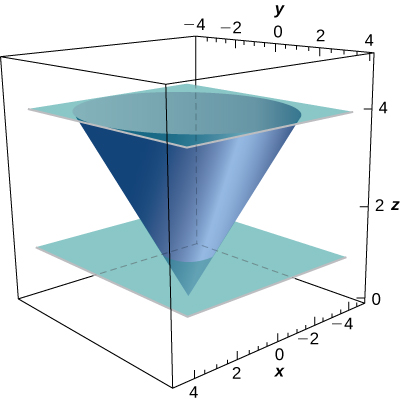
- Resposta
- \(\text{div}\,\vecs F = a + b\)
\(\displaystyle \iint_S x^2 zdS = \dfrac{1023\sqrt{2\pi}}{5}\)
30. [T] Evaluate \(\displaystyle \iint_S \frac{xz}{y} \, dS,\) where \(S\) is the portion of cylinder \(x = y^2\) that lies in the first octant between planes \(z = 0, \, z = 5\), and \(y = 4\).
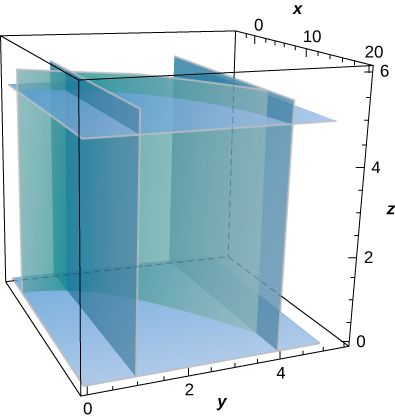
31. [T] Avalie\(\displaystyle \iint_S (z + y) \, dS,\) onde\(S\) está a parte do gráfico de\( z = \sqrt{1 - x^2}\) na primeira octante entre o\(xy\) plano -e o plano\(y = 3\).
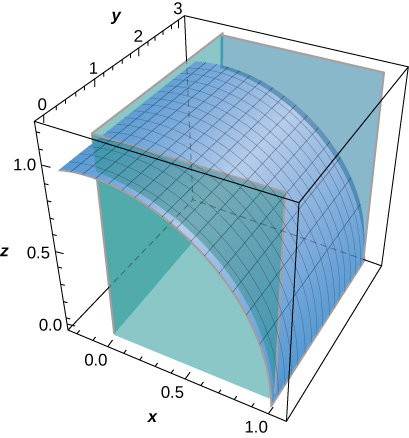
- Resposta
- \(\displaystyle \iint_S (z + y) \, dS \approx 10.1\)
32. Evaluate \(\displaystyle \iint_S xyz\, dS\) if \(S\) is the part of plane \(z = x + y\) that lies over the triangular region in the \(xy\)-plane with vertices (0, 0, 0), (1, 0, 0), and (0, 2, 0).
33. Find the mass of a lamina of density \(\xi (x,y,z) = z\) in the shape of hemisphere \(z = (a^2 - x^2 - y^2)^{1/2}\).
- Answer
- \(m = \pi a^3\)
34. Compute \(\displaystyle \int \int_S \vecs F \cdot \vecs N \, dS,\) where \(\vecs F(x,y,z) = x\,\mathbf{\hat i} - 5y\,\mathbf{\hat j} + 4z\,\mathbf{\hat k}\) and \(\vecs N\) is an outward normal vector \(S,\) where \(S\) is the union of two squares \(S_1\) : \(x = 0, \, 0 \leq y \leq 1, \, 0 \leq z \leq 1\) and \(S_2 \, : \, x = 0, \, 0 \leq x \leq 1, \, 0 \leq y \leq 1\).
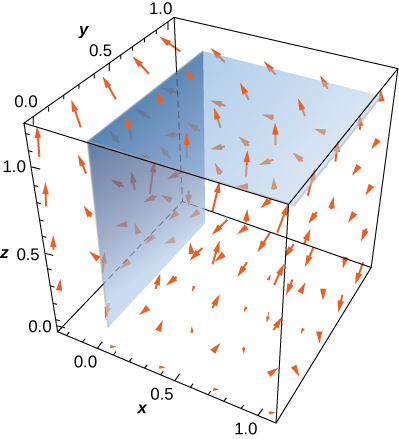
35. \(\vecs F(x,y,z) = xy\,\mathbf{\hat i} + z\,\mathbf{\hat j} + (x + y)\,\mathbf{\hat k}\)Calcule\(\displaystyle \int \int_S \vecs F \cdot \vecs N \, dS,\) onde e\(\vecs N\) é um vetor normal externo\(S,\) onde\(S\) está a região triangular cortada do plano\(x + y + z = 1\) pelos eixos de coordenadas positivas.
- Resposta
- \(\displaystyle \iint_S \vecs F \cdot \vecs N \, dS = \dfrac{13}{24}\)
36. \(\vecs F(x,y,z) = 2yz\,\mathbf{\hat i} + (\tan^{-1}xz)\,\mathbf{\hat j} + e^{xy}\,\mathbf{\hat k}\)Calcule\(\displaystyle \int \int_S \vecs F \cdot \vecs N \, dS,\) onde e\(\vecs N\) é um vetor normal externo\(S,\) onde\(S\) está a superfície da esfera\(x^2 + y^2 + z^2 = 1\).
37. \(\vecs F(x,y,z) = xyz\,\mathbf{\hat i} + xyz\,\mathbf{\hat j} + xyz\,\mathbf{\hat k}\)Calcule\(\displaystyle \int \int_S \vecs F \cdot \vecs N \, dS,\) onde e\(\vecs N\) é um vetor normal externo\(S,\) onde\(S\) está\(0 \leq x \leq 1, \, 0 \leq y \leq 1, \, 0 \leq z \leq 1\) faltando a superfície das cinco faces do cubo unitário\(z = 0\).
- Resposta
- \(\displaystyle \iint_S \vecs F \cdot \vecs N \, dS = \dfrac{3}{4}\)
Para os exercícios 38 a 39, expresse a integral da superfície como uma integral dupla iterada usando uma projeção\(S\) no\(yz\) plano.
38. \(\displaystyle \iint_S xy^2 z^3 \, dS;\)\(S\)é a primeira porção octante do plano\(2x + 3y + 4z = 12\).
39. \(\displaystyle \iint_S (x^2 - 2y + z) \, dS;\)\(S\)é a parte do gráfico\(4x + y = 8\) limitado pelos planos e planos coordenados\(z = 6\).
- Resposta
- \(\displaystyle \int_0^8 \int_0^6 \left( 4 - 3y + \dfrac{1}{16} y^2 + z \right) \left(\dfrac{1}{4} \sqrt{17} \right) \, dz \, dy\)
Para os exercícios 40 a 41, expresse a integral da superfície como uma integral dupla iterada usando uma projeção\(S\) no\(xz\) plano.
40. \(\displaystyle \iint_S xy^2z^3 \, dS;\)\(S\)é a primeira porção octante do plano\(2x + 3y + 4z = 12\).
41. \(\displaystyle \iint_S (x^2 - 2y + z) \, dS;\)é a parte do gráfico\(4x + y = 8\) limitado pelos planos e planos coordenados\(z = 6\).
- Resposta
- \(\displaystyle \int_0^2 \int_0^6 \big[x^2 - 2 (8 - 4x) + z\big] \sqrt{17} \, dz \, dx\)
42. Avalie a integral da superfície\(\displaystyle \iint_S yz \, dS,\) onde\(S\) está a primeira parte octante do plano\(x + y + z = \lambda\), onde\(\lambda\) está uma constante positiva.
43. Avalie a integral da superfície\(\displaystyle \iint_S (x^2 z + y^2 z) \, dS,\) onde\(S\) está o hemisf\(x^2 + y^2 + z^2 = a^2, \, z \geq 0.\)
- Resposta
- \(\displaystyle \iint_S (x^2 z + y^2 z) \, dS = \dfrac{\pi a^5}{2}\)
44. Avalie a integral da superfície\(\displaystyle \iint_S z \, dA,\) onde\(S\) está a superfície\(z = \sqrt{x^2 + y^2}, \, 0 \leq z \leq 2\).
45. Avalie a integral da superfície\(\displaystyle \iint_S x^2 yz \, dS,\) onde\(S\) está a parte do plano\(z = 1 + 2x + 3y\) que fica acima do retângulo\(0 \leq x \leq 3\)\(0 \leq y \leq 2\) e.
- Resposta
- \(\displaystyle \iint_S x^2 yz \, dS = 171 \sqrt{14}\)
46. Avalie a integral da superfície\(\displaystyle \iint_S yz \, dS,\) onde\(S\) está o plano\(x + y + z = 1\) que está no primeiro octante.
47. Avalie a integral da superfície\(\displaystyle \iint_S yz \, dS,\) onde\(S\) está a parte do plano\(z = y + 3\) que está dentro do cilindro\(x^2 + y^2 = 1\).
- Resposta
- \(\displaystyle \iint_S yz \, dS = \dfrac{\sqrt{2}\pi}{4}\)
Para os exercícios 48 a 50, use o raciocínio geométrico para avaliar as integrais de superfície fornecidas.
48. \(\displaystyle \iint_S \sqrt{x^2 + y^2 + z^2} \, dS,\)onde\(S\) está a superfície\(x^2 + y^2 + z^2 = 4, \, z \geq 0\)
49. \(\displaystyle \iint_S (x\,\mathbf{\hat i} + y\,\mathbf{\hat j}) \cdot dS,\)onde\(S\) é a superfície\(x^2 + y^2 = 4, \, 1 \leq z \leq 3\), orientada com vetores unitários normais apontando para fora
- Resposta
- \(\displaystyle \iint_S (x\,\mathbf{\hat i} + y\,\mathbf{\hat j}) \cdot dS = 16 \pi\)
50. \(\displaystyle \iint_S (z\,\mathbf{\hat k}) \cdot dS,\)onde\(S\) está o disco\(x^2 + y^2 \leq 9\) no plano\(z = 4\) orientado com vetores unitários normais apontando para cima
51. Uma lâmina tem a forma de uma porção da esfera\(x^2 + y^2 + z^2 = a^2\) que fica dentro do cone\(z = \sqrt{x^2 + y^2}\). \(S\)Seja a concha esférica centrada na origem com o raio a, e\(C\) seja o cone circular direito com um vértice na origem e um eixo de simetria que\(z\) coincide com o eixo. Determine a massa da lâmina se\(\delta(x,y,z) = x^2 y^2 z\).
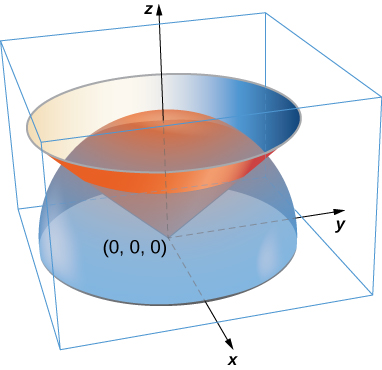
- Resposta
- \(m = \dfrac{\pi a^7}{192}\)
52. A lamina has the shape of a portion of sphere \(x^2 + y^2 + z^2 = a^2\) that lies within cone \(z = \sqrt{x^2 + y^2}\). Let \(S\) be the spherical shell centered at the origin with radius a, and let \(C\) be the right circular cone with a vertex at the origin and an axis of symmetry that coincides with the z-axis. Suppose the vertex angle of the cone is \(\phi_0\), with \(0 \leq \phi_0 < \dfrac{\pi}{2}\). Determine the mass of that portion of the shape enclosed in the intersection of \(S\) and \(C.\) Assume \(\delta(x,y,z) = x^2y^2z.\)
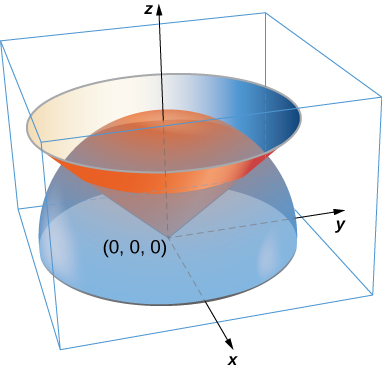
53. Um copo de papel tem a forma de um cone circular direito invertido de altura de 6 polegadas e raio de 3 polegadas superiores. Se o copo estiver cheio de água pesando\(62.5 \, lb/ft^3\), determine a magnitude da força total exercida pela água na superfície interna do copo.
- Resposta
- \(F \approx 4.57 \, lb\)
Para os exercícios 54 - 55, o campo vetorial de fluxo de calor para objetos condutores i\(\vecs F = - k\vecs\nabla T\), onde\(T(x,y,z)\) está a temperatura no objeto e\(k > 0\) é uma constante que depende do material. Encontre o fluxo externo\(\vecs F\) nas seguintes superfícies\(S\) para as distribuições de temperatura fornecidas e suponha\(k = 1\).
54. \(T(x,y,z) = 100 e^{-x-y}\);\(S\) consiste nas faces do cubo\(|x| \leq 1, \, |y| \leq 1, \, |z| \leq 1\).
55. \(T(x,y,z) = - \ln (x^2 + y^2 + z^2)\);\(S\) é esfera\(x^2 + y^2 + z^2 = a^2\).
- Resposta
- \(8\pi a\)
Para os exercícios 56 a 57, considere os campos radiais\(\vecs F = \dfrac{\langle x,y,z \rangle}{(x^2+y^2+z^2)^{\dfrac{p}{2}}} = \dfrac{r}{|r|^p}\), onde\(p\) está um número real. Vamos\(S\) consistir em esferas\(A\) e\(B\) centradas na origem com raios\(0 < a < b\). O fluxo externo total\(S\) consiste no fluxo externo através da esfera externa,\(B\) menos o fluxo para dentro\(S\) da esfera interna.\(A.\)
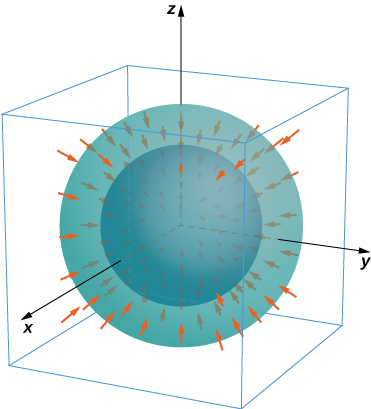
56. Encontre o fluxo total entre


